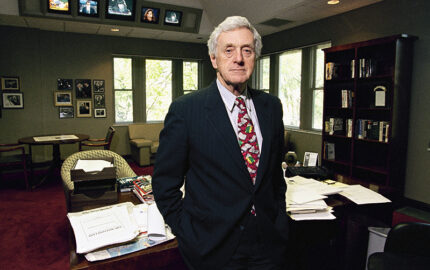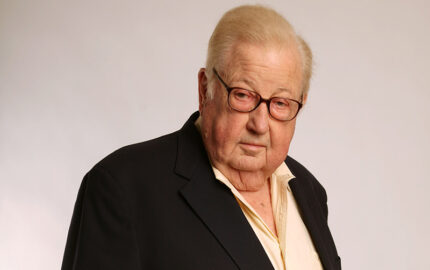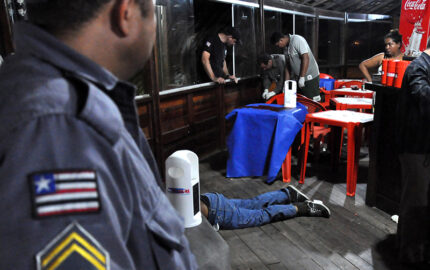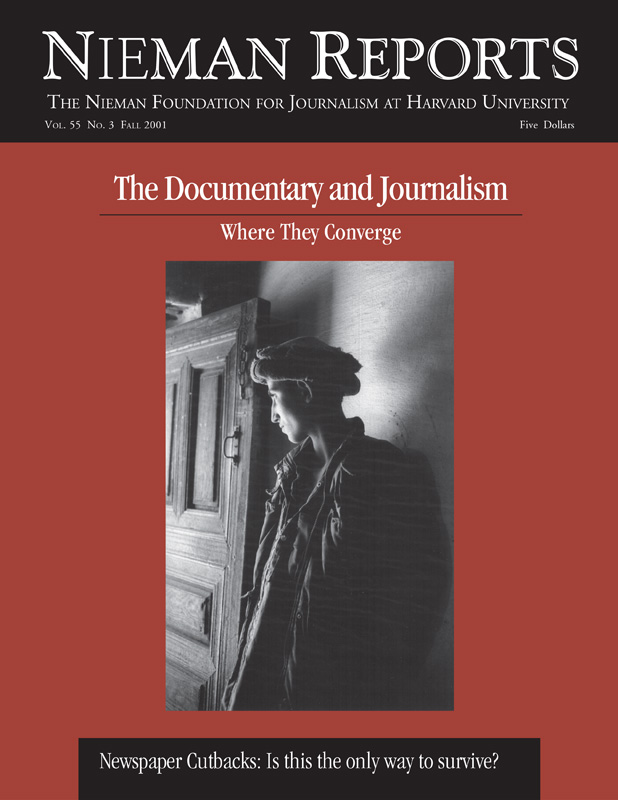
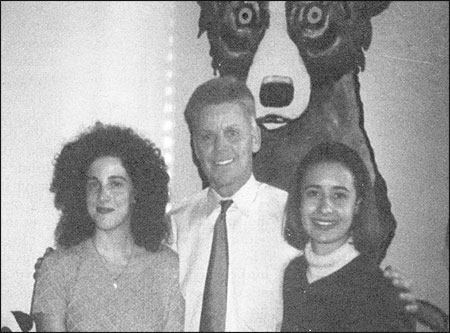
Chandra Ann Levy, Congressman Gary Condit, and Jennifer Baker shown in a November 2000 personal photo taken on a visit to Condit’s office before Jennifer Baker became an intern in his office. Photo courtesy of The Modesto Bee.
As executive director of the Carole Sund/Carrington Memorial Reward Foundation, I found myself in the midst of the top story in the nation—the missing Washington, D.C. intern—when the family turned to us for help. Our organization was established in memory of the three women murdered outside Yosemite National Park in February 1999 to assist families whose loved ones are missing or have been murdered. While our primary function is to post reward money for families in these circumstances who don’t have the resources to do so, we also act as a media liaison.
Our work with the media encompasses anything from providing a family spokesperson when the family is unable to speak with members of the media to assisting with fielding media calls and scheduling interviews for the family. Families who find themselves in these circumstances have no idea what to do or where to begin. So it was for the Levys when they contacted us only a few days after reporting their daughter missing.
Our experience with missing persons’ cases has taught us the importance of getting the media involved as quickly as possible. Time is of the essence, and often someone who might hear or see a report might have heard or seen something that could help locate this person. Within hours of our foundation being contacted, local broadcast media began calling me on my cell phone to cover the story at the request of their affiliates in D.C.
A press conference was quickly scheduled in the Levy home that afternoon. Two days later Mrs. Levy was sharing her daughter’s story with the country on “Good Morning America.” Soon the case of the missing 24-year-old intern was being aired across the nation as rumors of a potential romantic relationship with a congressman surfaced. I’m not certain how the rumors started, although many reporters called to ask me why Congressman Gary Condit posted a $10,000 reward.
As word traveled that a trip to Washington, D.C. was scheduled for her parents and myself, the story skyrocketed. We received a glimpse of what was to come when, just before our departure from California, we were paged and asked to deplane to take a phone call. Airline agents in Baltimore stated that they were being besieged with media calls and crews wanting to speak with the Levys upon their arrival at the airport. Baltimore airport officials worked diligently during our cross-country flight to prepare for this media onslaught and to have appropriate security measures in place.
Upon landing, we deplaned first and were greeted at the gate by security and airport personnel who notified us that the media were gathered and anxiously awaiting our arrival. With security surrounding us, we walked through the airport to the podium to make a few comments. After several minutes of comments and questions, we were on our way to our waiting car with security, camera crews, and reporters on all sides. One cameraman who was walking backwards in front of us fell over a large planter in his quest to videotape our walk to the car. While he fortunately was not injured, it showed us just what lengths those in the media would go through to cover this story.
Being surrounded by media and security in the airport was a new and overwhelming experience for these parents in the midst of such difficult circumstances. They were both emotionally and physically exhausted, yet they knew it was critical to get the word out about their missing daughter.
During our stay in D.C., our hotel provided a press room in which to conduct interviews. While we were there, media camped out at our hotel and either preceded our arrival or followed us to every meeting and appointment we had scheduled. Instantly the story of Chandra Levy, the missing intern, was the top story in the nation. Nearly every show called requesting an interview—“we need just a couple minutes of the Levys’ time,” they’d say. My cell phone rang nonstop at all hours. When I would attempt to listen to my messages, both lines of my cell phone would ring nonstop, preventing me from clearing my messages to allow room for more.
These moments proved a good reminder of why our foundation provides media liaison services. A family in this situation could never handle the media requests while they tried to get through each day. As it was, I was having a very difficult time and getting by on about three hours of sleep each night: Interviews began in early morning and continued late into the evening.
Having worked with media on several occasions in the past, I am fully aware of the competitiveness between the networks, particularly the morning shows. I understand how critical it is to be the “first” to air the story or to be the show that gets the “live” shot. Even before this experience, I’d been in the middle of two of the morning shows haggling over which one gets the live shot and who has to pre-tape and which gets the optimal location because of having to share space.
But this story was different. The networks and crews seemed to truly understand the pain this family was experiencing and worked together in ways I’d never experienced. They understood the family’s desire to get their daughter’s story out to the public in every way possible and were willing to do their part to help them accomplish that goal. They worked together to minimize the stress on the family even to the extent of sharing cameras for live shots so Mrs. Levy wouldn’t have to move to a new location or miss getting her daughter’s story on another show due to time constraints on the part of the networks. It was amazing to witness and a great example of how much can be accomplished when people work together toward a positive goal.
Not only did the crews and reporters work together and not argue over who got the first shot or the best location; they treated the Levys with great compassion both on and off camera. It helped to make an incredibly difficult and painful circumstance just a little easier for the family to endure. Many people, including some in the media, don’t realize that as families in difficult circumstances, such as the Levys, tell their story over and over, it’s like reopening a very painful wound. It’s extremely difficult, but they do it because they recognize its importance and are therefore willing to endure the pain. Understanding this emotional trade-off that families go through can help journalists be more effective when working with people who are in such difficult and painful situations.
While the majority of the bookers, producers, crews and reporters have been a pleasure to work with and very understanding of the emotional strain Chandra’s parents have been under, unfortunately there have been a few who went too far. There were the media “stalkers,” reporters who followed the family or myself wherever we went and yet claimed to have arrived at the particular location by chance. There was also a crew that followed the Levys on a weekend getaway when it had been agreed upon that they would be left alone for the weekend. The pool camera stayed, yet some individual networks followed them on their own.
At times, the media cooperated with each other while they camped out in front of the Levy home. The networks had agreed to use a pool camera outside the home to help alleviate the additional stress and strain of having multiple cameras, crews and reporters there and minimize subjecting the parents to the same questions over and over again. That was a tremendous help. At other times, relations were less than friendly. Occasionally, one network would complain to me about the behavior of another network—never anything major, but just enough that I would hear about it.
With the barrage of media calls a case like this elicits, it’s impossible to cooperate with each broadcast or print request. Rumors also abound as each network attempts to provide the very latest in the story. On several occasions, media outlets broadcast stories in which reporters cited another media organization as the source before looking into it themselves.
This kind of shoot-from-the-hip journalism occurred all too frequently. One producer with whom I had been working called and yelled at me, accusing me of lying to her because she saw a show announcing that they had an “exclusive” that I knew nothing about. She hadn’t taken time to find out the authenticity of the report or assess my possible knowledge of the situation. Instead, she called to yell and swear at me. Though I am well aware that a large and very critical component of her job is to establish a positive working relationship with me so as to acquire interviews for her network, our relationship and the trust level I had with her were greatly compromised after this incident.
There have also been several occasions when reports have been made that human remains were located or that they had credible information as to where Chandra’s body was buried. These reports turned out to be incorrect but, understandably, have been very painful for the family. It’s so difficult in high-profile cases to take the time to adequately research these tips before reporting them due to the pressure to be first to report new information. But practicing this type of unsubstantiated reporting is not only very stressful for the family involved but can, over time, erode public confidence in the news journalists convey.
The cable news channels have covered the story nonstop from the beginning. They cover it on several of their shows and often break into their shows to bring something live whenever they feel it could be of value. Often when they break into coverage with important news, they do so prematurely and end up having to explain that the tip or information was a hoax or turned out not to be related to the case. This coverage has been painful for the Levys; friends or family members see it air and call the family to tell them to turn it on. Watching these breaking news details on television, then having them turn out to be nothing, further jolts their emotions.
Many of the cable talk show hosts have been discussing the case with panels of experts with varying degrees of expertise. While their ongoing discussions about the case have kept Chandra’s story in front of the public, these often turn into battles and arguments in which no one’s point is heard as they are all talking over each other and so emotional, with little control on the part of the host.
Both print and broadcast media have shown a photograph of Chandra and Congressman Gary Condit. I’ve even read and heard reports in which they’ve stated that a picture of the congressman and Chandra was found in her apartment. Actually, this picture was taken of Chandra, the congressman, and a friend of hers, but some news organizations cropped it to show only Chandra and the congressman. This type of reporting is very misleading to the public; it deceives the viewer by telling the part of the story the media want to emphasize. Displaying the real photograph with the three of them presents a very different scenario than showing Chandra and the congressman alone.
In looking back over the past three months, working with the media in covering this case has been both a pleasure as well as an exhausting adventure. Being in the midst of a case of this magnitude is quite an experience. I’ve learned a lot and believe that many in the press have learned as well. My hope is that the compassion and caring attitude shown to Dr. and Mrs. Levy during this very difficult time could carry over and be offered to anyone being interviewed at tough times in their lives.
This experience also demonstrates again the immense power of the media to inform the entire nation, not to mention much of the world, and to do so at a speed that can be breathtaking—with positive or negative impacts. Solving a missing person’s case requires teamwork among law enforcement, families, the media, and the public. When media do their job responsibly and, as in this case, compassionately, the extraordinary strain on families such as the Levys will be eased.
Kim Petersen is the executive director of the Carole Sund/Carrington Memorial Reward Foundation (www.carolesundfoundation.com) which works with families whose loved ones are missing or have been murdered. She serves as an advocate and a liaison to law enforcement agencies for victims and their families.
